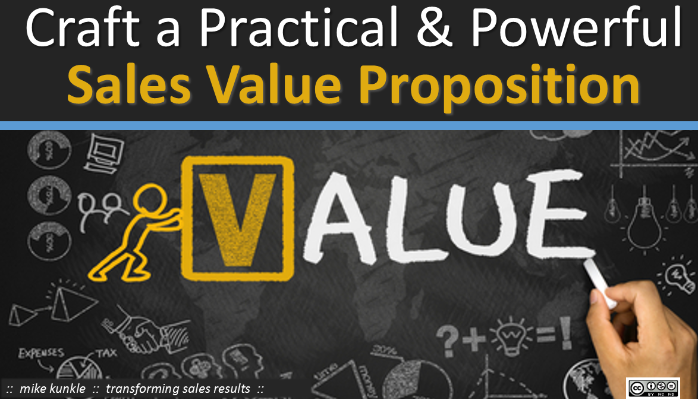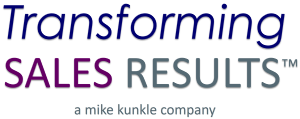Craft a Practical & Powerful Sales Value Proposition

Reality Check
Stop and think for a moment about the difference between the average high school theater production and an Oscar-winning movie.
Got that in your head?
Now, do the same with the average high school orchestra and the Chicago Symphony Orchestra (the “other” CSO).
Clear?
Now, do the same comparison for the average telemarketing call you receive at home and a true, professional B2B prospecting call.
Now, ask yourself… where am I – or where is my sales team – on that continuum?
From Point A to Point B
I worry that we’re living at a time when true self-awareness is on the decline, but given how much we hear about the inability of reps to communicate value and the dissatisfaction of senior executives with initial sales meetings, I’m guessing there are a fair amount of you who are feeling at least a little uneasy right now.
So what are the differences? I could produce a laundry-list, but I’m going to focus on two parallels that I hope are obvious:
- The amount of time spent in purposeful practice, honing one’s craft to reach mastery.
- The quality of interpretation and delivery of the screenplay script, the music on the page, or the sales messaging.
This post could now go in several directions, but I want to start by laying the foundation of crafting a well-designed, practical and powerful sales value proposition. I’m starting there because poor screenplays don’t win Oscars, hackneyed musical pieces don’t end up on the playbill of a word-class symphony, and even the best sales producers need relevant, compelling messaging to rise to the top of the profession.
The General Sales Value Proposition

There is a lot written about value propositions. It’s primarily a marketing concept but it certainly transfers to selling. I’ve developed my own materials over the years, but admit I’m particularly fond of Futurecurve’s work and give them a nod here. (They also have a solid white paper on sales insights.)
To use your Sales Value Proposition to sell more effectively in a Buyer-Oriented Selling System™:
- STEP 1: Document common Market and Buyer Problems/Risks/Opportunities (PRO), Negative Impacts, Business Needs, and Desired Outcomes.
- STEP 2: Document your Solution Architecture language and create Sales Messaging.
- STEP 3: Gather Proof Statements and stories to back up the messages.
- STEP 4: Aim the messages at the right Market (marketing), personalizing for each Buyer (sales).
General Market / Buyer Issues
This is the specific group of customers you are targeting.
- You may focus on industries/verticals, such as healthcare or automotive
- You certainly should have target companies in those verticals, such as Ascension Health or AutoNation Inc.
- Within those companies, you’ll likely target Buyer Personas or roles, such as CFOs, COOs, or VPs of Procurement.
The market you serve and buyers you target usually face a relatively well-known set of issues. Here’s how I categorize them:
- They face Problems, Risks, and Opportunities (PRO)
- If you don’t resolve the Problems, minimize of eliminate the Risks, or achieve the Opportunities, there are negative consequences, or Impacts.
- Those Impacts create business Needs.
- The Needs lead to Desired Outcomes.
Solution Architecture
The whole is greater than the sum of its parts…
From the Product Perspective:
- You have a Product or Service (I’ll use “product” for simplicity).
- Your Product has Features which are factual characteristics.
- The way a feature works or what it does is the Advantage. (A feature may provide a Competitive Advantage over other similar products).
- The way you combine your Features and Advantages to address business issues for your clients become your Solution.
From the Buyer Perspective:
- A Feature and its Advantage (and Competitive Advantage, if any) provide a Benefit to customers by addressing an issue for them, usually by avoiding Negative Impacts (solve a Problem, avoid a Risk, enable an Opportunity). Benefits are entirely from the buyer’s point of view, and this is a critical distinction.
- That Benefit produces a business result or a Desired Outcome.
- The Desired Outcomes provide business Value – impacting the Metrics That Matter for the business and the way that the buyers/decision-makers are measured. Value may include things other than financial, such as the achievement of mission or vision, but is very compelling when dollarized. This is the ROI.
There is Value when the Outcomes minus [Solution Costs + Change Pain] is greater than the PRO (the Problems, Risks, or Opportunity Loss)
Hopefully, it’s obvious how your Solution connects to the PRO, to deliver the Desired Outcomes and Value your buyers need. However, if you’re going to effectively communicate that value, you’re going to need some…
Proof Statements
This is substantiation of your claims about your offering. You can offer proof through:
- Success Stories and Examples
- Case Studies
- Customer Testimonials
Real examples are best, dollarized whenever possible, and are even more powerful when they include your customer’s perspective, quotes, outcomes or endorsements.
Considerations for Personalized Sales Value Propositions

Taking your sales value proposition to the next level is not that difficult, it just requires specific information from a given buyer – a real person versus a role or persona or market SWOT analysis.
Buyer PRO
Now we’re talking about real people… a contact / decision-maker or influencer in a real account (such as John Wilkins, COO for ACME Health Systems)
Much of the issue structure is exactly the same, except you’d plug in the specifics about the buyer’s situation:
- Problems/Risks/Opportunities (PRO)
- Negative Impacts
- Business Needs
- Desired Outcomes
This time, you simply go deeper to include the things that you know about the person, as well:
- Personal Motivators (personal goals, career/political considerations, emotional factors)
- Metrics that Matter (tied to how the specific buyer is measured)
- Buying Process and their role in it
- Decision Criteria and Exit Criteria
- Budget (or where the funding is coming from, if not budgeted)
- Timeframe (if time-sensitive)
Personalized Solution Value
If you have access to the information, this is a tremendous opportunity to personalize the value equation. You have Value when:
Outcomes – [Solution Costs + Change Pain] > PRO
Whenever you can plug real data into this equation and show the potential ROI for your Solution recommendations, it’s an obvious win and a clear way to demonstrate compelling value, to get past the “No Decision” stall.
Everything I Just Told You May Be Wrong
Okay, not quite, but I do want to point out a very real limitation to anything that you do that isn’t tied to your customer’s current reality.
For example, the second version of the personalized value prop for a real buyer is closer to reality that than the initial generic market version. Yet, even the generic version is still better than winging it.
These value propositions and any resulting sales messaging are effective for prospecting and for use early in the buying/sales process where you may not have quite the deep buyer detail you need to truly personalize, or communicate the value you have constructed or co-created with them. At later stages of the sales process, you need to have constructed or co-created value with them, to achieve maximum effectiveness.
Co-creating or constructing value together with your customers is powerful. This is a foundational element from Futurecurve, is also reported from my friends at RAIN Group, and often discussed by Dave Brock, Tamara Schenk, Brian MacIver and others. Here’s a view of this, adapted slightly from Futurecurve’s work:
(click graphic to enlarge)
I can’t go into more detail in this post, but any post on sales value propositions that doesn’t mention the limits of sales messaging and the power of true value construction, is misleading and does a disservice to the reader. So for now, I’ll end here for today, but will be back to this topic in a future post.
________________________________________________________________
As usual, this is what I think. More importantly… What do YOU think?
I’d enjoy hearing your thoughts and experiences in the comments. I’ve also included some related resources below, that I hope you’ll find helpful.
As always, thanks for reading, be safe out there, and by all means… let’s continue to elevate our sales profession.
Mike Kunkle
:: transforming sales results ::
Let’s get connected:
- Blog: https://www.mikekunkle.com
- LinkedIn: http://www.linkedin.com/in/mikekunkle
- LinkedIn Pulse: http://bit.ly/MikeKunklePulse
- Twitter: https://twitter.com/mike_kunkle
- Google+: http://gplus.to/mikekunkle
- Slideshare: http://bit.ly/MK-slideshare
Related Resources
- http://trustedadvisor.com/articles/why-value-propositions-are-overrated
- http://caddellinsightgroup.com/blog2/2009/03/another-kind-of-value-proposition/
- http://www.rainsalestraining.com/blog/5-changes-in-b2b-buying-behavior-you-need-to-know-about/
- http://brianmaciver.blogspot.com/2011/11/if-you-want-to-sell-value-then-you-had.html
- http://www.futurecurve.com/blog/8-tips-to-building-a-sales-persons-value-proposition
- http://www.futurecurve.com/blog/do-you-care-more-about-your-products-than-your-customers
- http://www.futurecurve.com/downloads



